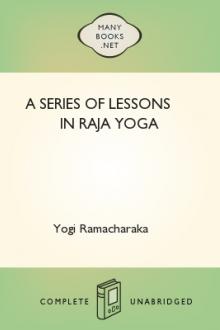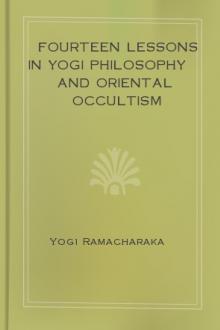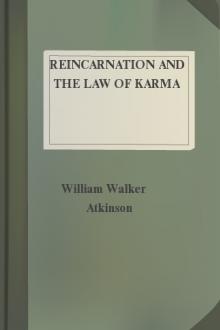A Series of Lessons in Raja Yoga by William Walker Atkinson (e reader txt) 📕

- Author: William Walker Atkinson
- Performer: 0766127001
Book online «A Series of Lessons in Raja Yoga by William Walker Atkinson (e reader txt) 📕». Author William Walker Atkinson
But we must postpone our consideration of this more than interesting phase of the subject, until some future lesson, when we shall take a trip into the regions of Mind, under and above Consciousness. And a most wonderful trip many of us will find it, too.
For the present, we must pay our attention to the channels by which the material for knowledge and thought enter our minds. For these sense impressions, coming to us from without, are indeed "material" upon which the mind works in order to manufacture the product called "Thought."
This material we obtain through the channels of the senses, and then store in that wonderful storehouse, the Memory, from whence we bring out material from time to time, which we proceed to weave into the fabric of Thought. The skill of the worker depends upon his training, and his ability to select and combine the proper materials. And the acquiring of good materials to be stored up is an important part of the work.
A mind without stored-up material of impressions and experiences would be like a factory without material. The machinery would have nothing upon which to work, and the shop would be idle. As Helmholtz has said, "Apprehension by the senses supplies directly or indirectly, the material of all human knowledge, or at least the stimulus necessary to develop every inborn faculty of the mind." And Herbert Spencer, has this to say of this phase of the subject, "It is almost a truism to say that in proportion to the numerousness of the objects that can be distinguished, and in proportion to the variety of coexistences and sequences that can be severally responded to, must be the number and rapidity and variety of the changes within the organism—must be the amount of vitality."
A little reflection upon this subject will show us that the greater degree of exercise and training given the senses, the greater the degree of mental power and capability. As we store our mental storehouse with the materials to be manufactured into thought, so is the quality and quantity of the fabric produced.
It therefore behooves us to awaken from our "lazy" condition of mind, and to proceed to develop our organs of sense, and their attendant mechanism, as by doing so we increase our capacity for thought and knowledge.
Before passing to the exercises, however, it may be well to give a hasty passing glance at the several senses, and their peculiarities.
The sense of Touch is the simplest and primal sense. Long before the lower forms of life had developed the higher senses, they had evidenced the sense of Touch or Feeling. Without this sense they would have been unable to have found their food, or to receive and respond to outside impressions. In the early forms of life it was exercised equally by all parts of the body, although in the higher forms this sense has become somewhat localized, as certain parts of the body are far more sensitive than are others. The skin is the seat of the sense of Touch, and its nerves are distributed over the entire area of the skin. The hand, and particularly the fingers, and their tips, are the principal organs of this sense.
The acuteness of Touch varies materially in different parts of the body. Experiments have shown that a pair of compasses would register impressions as a very slight distance apart when applied to the tip of the tongue. The distance at which the two points could be distinguished from one point, on the tip of the tongue, was called "one line." Using this "line" as a standard, it was found that the palmar surface of the third finger registered 2 lines; the surface of the lips 4 lines, and the skin of the back, and on the middle of the arm or thigh, as high as 60 lines The degree of sensitiveness to Touch varies greatly with different individuals, some having a very fine sense of touch in their fingers, while others manifested a very much lower degree.
In the same way, there is a great difference in the response of the fingers to weight—a great difference in the ability to distinguish the difference of the weight of objects. It has been found that some people can distinguish differences in weight down to very small fractions of an ounce. Fine distinctions in the differences in temperature have also been noticed.
The sense of touch, and its development has meant much for Man. It is the one sense in which Man surpasses the animals in the matter of degree and acuteness. The animal may have a keener smell, taste, hearing and sight, but its sense of Touch is far beneath that of Man. Anaxagoras is quoted as saying that "if the animals had hands and fingers, they would be like men."
In developing the sense of Touch, the student must remember that Attention is the key to success. The greater the amount of Attention the greater the degree of development possible in the case of any sense. When the Attention is concentrated upon any particular sense, the latter becomes quickened and more acute, and repeated exercise, under the stimulus of Attention, will work wonders in the case of any particular sense. And on the other hand, the sense of touch may be almost, or completely inhibited, by firmly fixing the Attention upon something else. As an extreme proof of this latter fact, the student is asked to remember the fact that men have been known to suffer excruciating torture, apparently without feeling, owing to the mind being intently riveted upon some idea or thought. As Wyld has said, "The martyr borne above sensuous impressions, is not only able to endure tortures, but is able to endure and quench them. The pinching and cutting of the flesh only added energy to the death song of the American Indian, and even the slave under the lash is sustained by the indignant sense of his wrongs."
In the cases of persons engaged in occupations requiring a fine degree of Touch, the development is marvelous. The engraver passes his hand over the plate, and is able to distinguish the slightest imperfection. And the handler of cloth and fabrics is able to distinguish the finest differences, simply by the sense of touch. Wool sorters also exercise a wonderfully high degree of fineness of touch. And the blind are able to make up for the loss of sight by their greatly increased sense of Touch, cases being recorded where the blind have been able to distinguish color by the different "feel" of the material.
The sense of Taste is closely allied to that of Touch—in fact some authorities have considered Taste as a very highly developed sense of Touch in certain surfaces of the body, the tongue notably. It will be remembered that the tongue has the finest sense of Touch, and it also has the sense of Taste developed to perfection. In Taste and Touch the object must be brought in direct contact with the organ of sense, which is not the case in Smell, Hearing, or Sight. And, be it remembered, that the latter senses have special nerves, while Taste is compelled to fall back upon the ordinary nerves of Touch. It is true that Taste is confined to a very small part of the surface of the body, while Touch is general. But this only indicates a special development of the special area. The sense of Taste also depends to a great extent upon the presence of fluids, and only substances that are soluble make their presence known through the organs and sense of Taste.
Physiologists report that the sense of Taste in some persons is so acute that one part of strychnine in one million parts of water has been distinguished. There are certain occupations, such as that of wine-tasters, tea-tasters, etc., the followers of which manifest a degree of fineness of Taste almost incredible.
The sense of Smell is closely connected with the sense of Taste, and often acts in connection therewith, as the tiny particles of the substance in the mouth arise to the organs of Smell, by means of the opening or means of communication situated in the back part of the mouth. Besides which the nose usually detects the odor of substances before they enter the mouth. The sense of Smell operates by reason of the tiny particles or the object being carried to the mucous membrane of the interior of the nose, by means of the air. The membrane, being moist, seizes and holds these particles for a moment, and the fine nervous organism reports differences and qualities and the Mind is thus informed of the nature of the object.
The sense of Smell is very highly developed among animals, who are compelled to rely upon it to a considerable extent. And many occupations among men require the development of this sense, for instance, the tobacconist, the wine dealer, the perfumers, the chemist, etc. It is related that in the cases of certain blind people, it has been observed that they could distinguish persons in this manner.
The sense of Hearing is a more complex one than in the case of Taste, Touch and Smell. In the latter three the objects to be sensed must be brought in close contact with the sense-organs, while in Hearing the object may be far removed, the impressions being carried by the vibrations of the air, which are caught up and reported upon by the nervous organism of the sense of Hearing. The internal mechanism of the ear is most wonderfully intricate and complex, and excites to wonder the person examining it. It cannot be described here for want of space, but the student is advised to inquire into it if he has access to any library containing books on the subject. It is a wonderful illustration of the work of the mind in building up for itself instruments with which to work—to acquire knowledge.
The ear records vibrations in the air from 20 or 32 per second, the rate of the lowest audible note, to those of 38,000 per second, the rate of the highest audible note. There is a great difference in individuals in regard to the fineness of the sense of Hearing. But all may develop this sense by the application of Attention. The animals and savages have wonderfully acute senses of Hearing developed only along the lines of distinctness, however—on the other hand musicians have developed the sense along different lines.
The sense of Sight is generally conceded to be the highest and most complex of all the senses of Man. It deals with a far larger number of objects—at longer distances—and gives a far greater variety of reports to the mind than any of its associate senses. It is the sense of Touch magnified many times. As Wilson says of it, "Our sight may be considered as a more delicate and diffusive kind of touch that spreads itself over an infinite number of bodies; comprehends the largest figures, and brings into our reach some of the most remote parts of the universe."
The sense of Sight receives its impressions from the outside world by means of waves that travel from body to body—from sun to earth, and from lamp to eye. These waves of light arise from vibrations in substance, of an almost incredible degree of rapidity. The lowest light vibration is about 450,000,000,000,000 per second, while the highest is about 750,000,000,000,000 per second. These figures deal only with the vibrations recognizable by the eye as light. Above and below these figures of the scale are countless other degrees invisible to the eye, although some of them may be recorded by instruments. The different sensations of color, depend upon the rate of the vibrations, red being the limit of the lowest, and violet the limit of the highest visible vibrations—orange, yellow, green, blue, and indigo being the intermediate rates or colors.
The cultivation of the sense of Sight, under the aid of Attention is most important to ail persons. By being able to clearly see and distinguish the parts of an object, a degree of knowledge regarding it is obtained that one may





Comments (0)